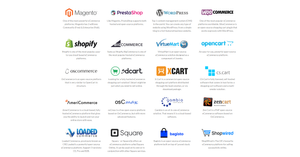The 3 Biggest eCommerce Mistakes You Can Easily Avoid
Have you ever wondered what makes an eCommerce website successful?
I thought that a good starting point to answer this question would be to look from a reversed perspective.
So let's try to understand what actually makes an e-commerce site less successful, or even bad.
Once you figure out the usual bad practices, you will know what to avoid if you want to run a [more] successful e-commerce business.
In fact, there are 3 most common mistakes at work. I'll reveal all 3 in a minute.
Furthermore, I intend to show you how e-commerce can perform much better than it is now.
In other words:
By looking at every metric available, digital commerce is continuing to grow at an insane speed.
The Adobe Digital Economy Index reported eCommerce is up 49% during the shelter-in-place in the US, online grocery sales went up 110%, electronics sales up 58%, and apparel sales are up 34%.
That's unprecedented.
But there's no doubt that exponential growth is still to come.
So let’s see what can be done to improve an e-commerce website to perform better in terms of customer experience.
Before doing a deep dive into details, let's not forget we are in 2022:
- Mobile-first website design has been a standard for a long time;
- Visa and MasterCard are all geared up toward frictionless checkout;
- Digital commerce is moving from monolith solutions to headless commerce.
Now,
For those who do not know me, I work in the Customer Operations here at SIA Central Europe, so I look at eCommerce websites all day long.
In my line of work, I am used to seeing tons of mediocre, and occasionally a very few exceptional eCommerce websites.
Still, I get so disappointed each time I discover a new eCommerce site that lacks the basic elements of a successful web-store.
This is especially annoying if that specific website is selling costly, premium products or services.
Do you want to charge a premium price?
How about offering a premium shopping experience?
So let's dive right in.
This is the list of the most common e-commerce bad practices that can ruin customer experience and webshop profit.
3 mistakes that most e-commerce shops make:
Without further ado, let's get down to the nitty-gritty and explain what parts you'll need to master to succeed in 2022:
Mistake #1: Complicated Checkout Process
Once a potential customer has landed on your website, browsed around, selected a product he wants to buy, and finally headed to the checkout process, all you have to do is take his money. And make the checkout process as easy as possible, flawless and straightforward.
But often, this is not the case.
It is unbelievable how some e-commerce websites lose the sale just because they prefer to put additional annoying rules that make consumers abandon the process at the very end.
The truth is, lot of webshops have illogical checkout process that is hard to understand, and sometimes is even more complex than the International Space Program!
ACTION ITEM: Check your "cart abandon rate", it should tell you how many visitors have landed on your site, selected a product, started the checkout process and abandoned - returned to where they originally came from, by hitting the back button.
HOW TO SOLVE THIS: Review and cut the number of steps in your checkout process and make them more intuitive. Start working on UI/UX improvements.
Also, encourage shoppers to create a profile, but do not force them! Use an effective, ethical bribery - give a discount or a freebie in exchange for an email address.
And finally, send shopping cart abandonment emails to those who completed their profile but did not go through the complete checkout process.
Mistake #2: Slow Page Loading
The massive expansion of online retailing means that every business in this sector must ensure their shop storefront is fully efficient.
Your website is your storefront, and how it looks and how fast it loads makes all the difference in getting people in the door.
Consumers looking to buy a product are quite eager to find what they are looking for.
Do you think that they would prefer an e-commerce website that takes 10 seconds to load over the one that loads in under 2 seconds?
With slow loading and prolonged waiting, the user always has a doubt -"What's going on, is there something wrong with this website? Has my internet connection suddenly dropped?".
As a consumer, I do not like waiting for 5 or 12 seconds (or even more!) for a webpage to load. Pages have to be served super-fast!
If your webshop cannot deliver the page in 2 seconds or less - I'll bounce instantly, return to google and go to the next search result and website, which will open faster and eventually buy from them.
ACTION ITEM: Check your "bounce rate" in Google analytics. It will tell you how many visitors have landed on your site, concluded that your website sucks, and instantly returned to where they first came from by hitting the back button.
HOW TO SOLVE THIS: Work with your frontend team to identify the issues and bottlenecks. If not sure what to do, go first for the "low hanging fruit" - optimize large media files and images.
Also, check if your webserver is holding you back and move to a more resourceful hosting if needed. Actually easier said than done, but you need to start with something. Make a bold first step by entering your webshop URL address into this free google tool.
To find out more, check out this article about my favorite online tools and services that can help you improve your website.
Mistake #3: Bad Mobile Experience
To succeed in 2022, your eCommerce site NEEDS to work well on any device (Desktops, tablets, phones and even TVs).
Did you know that nearly 1.3 million new Android devices are activated across the world every day?
An e-commerce website that's not mobile-friendly and has a "Desktop only" version of a website is merely unacceptable today.
Yet some e-commerce websites are still in a web "stone age" - Desktop only. When I open the page on my cell phone, I do not expect to see the same thing as on my desktop PC!
Not to mention that text on such a webpage usually cannot be read on mobile devices without zooming, pinching and moving around the screen.
Often, when I see that kind of unreadable website on my cellphone, I feel the urge to instantly hit the back button and bounce back to google search results expecting that my next choice will return a mobile-friendly page.
ACTION ITEM: Check "Device category share" under Audience>Mobile>Overview in Google analytics. It will tell you what percentage of your visitors use desktop vs. mobile (and tablets).
HOW TO SOLVE THIS: Work with your website designer and frontend team to find the most effective solution to this problem. On some platforms, it is way easier to switch to an entirely new website theme (skin) than fixing existing website design to make it responsive or mobile-friendly.
That's not everything though;
The Worst of All Mistakes: Wrong Mindset
Of course, there's more to a successful webshop than what I have just described. Those 3 things are the foundation that you need to be aware of and try to improve on.
Furthermore, in addition to the practices mentioned above, we can easily classify any e-commerce website into one of the following two categories:
- A site that treats its consumers with respect offering a unique, fast, and easy way to shop online. The philosophy behind: Create extraordinary online shopping experience. Use every opportunity to convince potential customers that your brand is unique, your service is exceptional, your merchandize is special - persuade them to buy and make the online shopping process seamless, easy, and joyful! Customer perspective is something that is most important; the customer has to be treated with respect.
- A site that treats its customers dumb. The philosophy behind: Consumers have landed on our website, entered our web store, so if they want to buy something from us, they can certainly wait another 15-20 seconds for our not-optimized pages to load. And they can certainly fill out tons of unnecessary personal and other data during the checkout process. They will have to live with our desktop site on their mobile device. If they do not know how to zoom the text on a cellphone, if they do not like our restrictions and rules, or the overall experience - we do not need them! Let those spoiled consumers shop somewhere else.
Believe it or not, there are still too many e-commerce businesses that fall under the second category.
But that's not the worst part. (Though it is all pretty awful.)
Sometimes, it looks the eCommerce website's existence is self-sufficient and not because of online consumers in the first place!
The fact that some online stores are pioneers in these fields doesn't compensate for their neglect towards the e-commerce consumer shopping experience.
Some merchants are going above and beyond, like using a BINlist to enhance the customer experience and manage both costs and fraud.
Now,
You have to try to learn more about where your website falls short and needs the most improvement.
And then start working on it with your team.
I'd also like to hear from you: What strategies have you considered (or actually used) to improve your e-commerce website?
Is there another approach, bad practice, or common mistake you consider crucial for a successful webshop?
If you found this post helpful, I'd appreciate if you would share it.
Author: Drasko Georgijev
I'm a financial technology professional with 15+ years of experience in payment cards, eCommerce, transaction processing and switching.
From time to time, I'm sharing some useful tips, tactics and news about Digital Commerce, Digital Marketing, and Fintech.
So don't forget to share this post and subscribe to my mailing list.
And do let me know what you think via email drashco [at] ecommthatworks.com - I read every email. Talk Soon.
Also, are we connected on LinkedIn yet? If not, feel free to send me a personal invitation on LinkedIn.





